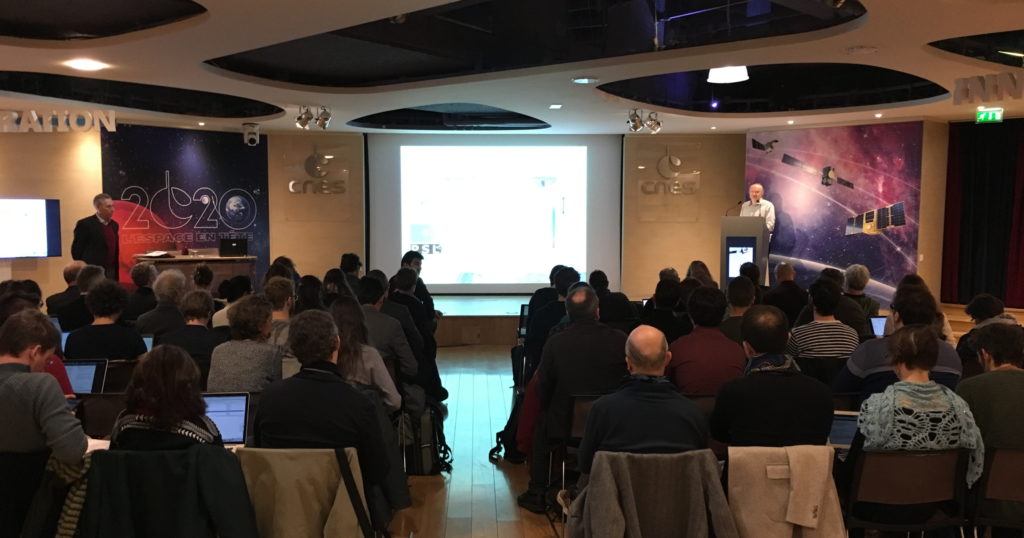EnVision Conference
Paris, 12-14 Feb 2020
Scope of the conference
You are warmly invited to join the first international conference to discuss the scientific investigations of the EnVision mission at CNES headquarters in central Paris, France from 12-14 February 2020. The conference will welcome all presentations related to the EnVision mission’s payload and its science investigations.
EnVision is a proposed orbiter mission aiming at determining the level and nature of the geological activity and the sequence of events that generated the surface features of Venus, assessing whether Venus once had oceans (and was thus perhaps hospitable for life) and understanding the geodynamics framework that controls the release of internal heat over Venus’ history. EnVision will use a number of different techniques to search for active geological processes, measure changes in surface temperature associated with active volcanism, characterise regional and local geological features, determine crustal support mechanisms and constrain mantle and core properties.
The mission would be launched on an Ariane 6.2 in 2032, arriving at Venus after a five month cruise, to perform 4 years of measurements with 5 cutting-edge instruments : an S-band Synthetic Aperture Radar (VenSAR), a Subsurface Radar Sounder (SRS) and VenSpec, a suite of three spectrometers and spectro-imagers : VenSpec-M (Infrared Imager), VenSpec-H (IR spectrometer), and VenSpec-U (UV spectrometer). Envision will also characterise the gravity field of Venus thanks to a Radio Science Experiment. The mission is currently in its concept study phase for a selection expected in 2021. EnVision would be an ESA mission, with a significant contribution and potential sharing of responsibilities with NASA currently under scientific, technical and programmatic assessment.
Venus exploration presents clear opportunities to address fundamental questions about the evolution of terrestrial planets and the appearance of life within our own solar system. Comparing the interior, surface and atmosphere evolution of Earth and Venus is essential to understanding what internal processes drove habitability of our own planet This is particularly true in an era where we expect hundreds, and then thousands, of Earth or Venus-sized exoplanets to be discovered.
Sessions
Six sessions extended over the three days, with session scheduling allowing for oral remote presentations as well as on-line viewing at a selection of world time zones incl. PST UTC-8, EST UTC-5, JST UTC+9. A large time will be dedicated to discussion and interaction between participants.

Conference Program and Abstracts
Venue and Accomodation
Presenter’s information
Scientific Organizing Committee
- Thomas Widemann, LESIA, Observatoire de Paris, France (Chair)
- Veronique Ansan, LPG, University de Nantes, France
- Francesca Bovolo, CICT, Fondazione Bruno Kessler, Italy
- Doris Breuer, DLR Institute of Planetary Research, Berlin, Germany
- Lorenzo Bruzzone, Università di Trento, Italy
- Bruce Campbell, Center for Earth and Planetary Studies, National Air & Space Museum, Washington, DC
- Anne Davaille, FAST, Université Paris-Saclay, Orsay, France
- Caroline Dumoulin, LPG, Université de Nantes, France
- Alice le Gall, LATMOS, IPSL, France
- Cedric Gillmann, Free University of Brussels, Belgium
- Richard Ghail, Dpt. Earth Sciences, Royal Holloway, University of London, UK
- Jörn Helbert, DLR Institute of Planetary Research, Berlin, Germany
- Scott Hensley, NASA/Caltech Jet Propulsion Laboratory, Pasadena, CA
- Walter Kiefer, Lunar and Planetary Institute, Houston, TX
- Goro Komatsu, IRSPS, Università degli Studi G. d’Annunzio Chieti e Pescara, Italy
- Mikhail Ivanov, V.I. Vernadsky Institute of Geochemistry and Analytical Chemistry, Russian Academy of Sciences, Moscow, Russia
- Emmanuel Marcq, LATMOS, IPSL, France
- Philippa Mason, Dpt. Earth Science & Engineering, Imperial College, London, UK
- Pascal Rosenblatt, LPG, Université de Nantes, France
- Takehiko Satoh, Institute of Space and Astronautical Science, JAXA, Japan
- Christophe Sotin, NASA/Caltech Jet Propulsion Laboratory, Pasadena, CA
- Aymeric Spiga, Laboratoire de Météorologie Dynamique (LMD), IPSL, France
- Ann Carine Vandaele, Royal Belgian Institute for Space Aeronomy (BIRA/IASB), Belgium
- Colin Wilson, Dpt. Physics, University of Oxford, UK
